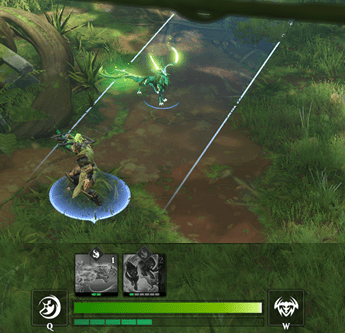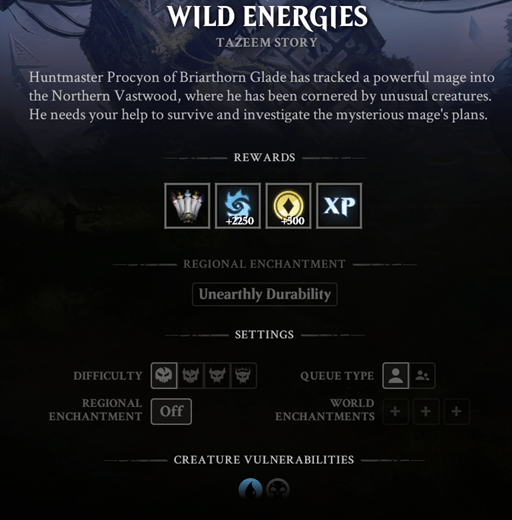
Last week, Magic Legends (an Action RPG MMO based on the Magic: The Gathering universe) started it’s Open Beta period, and as a good MTG fanboy I had to try it out.
After several hours casting spells and travelling through planes killing everything that had a health bar, I think I’ve seen enough to have a general idea of the game mechanics and what intentions for the game are.
So in case you’re still wondering if you should play or just want to know the basics, here is my quick analysis and predictions:
WHAT’S MAGIC LEGENDS?
For those that are not familiar with it, we can define Magic Legends as a free-to-play Diablo-like MMORPG based in the popular Magic: The Gathering collectible card game (about which I’ve already spoken at my blog).
The game is available in PC in several stores including the Epic Store, and is expected to be released later in this year in Playstation and Xbox.

Magic Legends has a look-n-feel which strongly remind Diablo and other Action RPGs (isometric pov, click-to-attack, etc).
Magic Legends has a look-n-feel which strongly remind Diablo and other Action RPGs (isometric pov, click-to-attack, etc).
The game is the latest MMO’s developed by Cryptic Studios (Star Trek Online, Champions Online…), which is subsidiary of Perfect World Entertainment (a games publisher specialized on free-to-play MMORPGS).
These folks have released tons of MMOs, and are among the biggest experts on this genre in the industry right now.
A bit surprisingly, coming from devs used to employ a similar formula for many of their games, Magic Legends either simplifies, removes or hides some features that are standard of MMORPGs like Guilds, Crafting, Item Looting or Tradehouses.
Instead, it puts a huge focus in the action gameplay and character progression.
Gameplay
The game has a bit of an frankenstein design, since it mixes mechanics from MMORPG, Action RPG and CCG:
From Action RPG, it gets the combat system, which requires a high level of micromanagement and a high actions-per-minute (APM) ratio.
This is primarily because the player needs to target enemies and attack by clicking on them repeatedly (because the game doesn’t lock enemies. Players need to click for every attack, like Diablo), as well as cast a range of skills that are as demanding in terms of timing, positioning as they would be on a MOBA.
A peculiarity compared to most other Action RPGs is the game features a lot of spells which summon companion creatures which help you on the fight until killed.
A negative point is that the visuals of the game make it a bit difficult to spot enemies, which sometimes are too well camouflaged with the environment.
This is particularly problematic because the game requires players to be constantly tapping on enemies to attack.
The game could’ve benefited from adding cell-shading graphics or some clear outline on units (like League of Legends does), which would help make them more recognizable.

An example of micromanagement: The Rending Throw (Q) skill of the green planeswalker launches a spinning axe to the enemy and requires the right position to hit multiple enemies. Similar to this, many of the abilities require dexterity to maximize its value.
An example of micromanagement: The Rending Throw (Q) skill of the green planeswalker launches a spinning axe to the enemy and requires the right position to hit multiple enemies. Similar to this, many of the abilities require dexterity to maximize its value.
From MMORPG, it gets both the instanced dungeons system that players can raid and grind solo or with others, and a range of upgrade axises (Equipment, Artifacts, Traits…).
Interestingly, the game seems to lack the looter component on the instances: Enemies quickly disappear once killed, not dropping items, gold, etc. Instead, it’s finishing instances which grants rewards.
This makes balancing easier (designers can put infinite enemies without having to worry about the potential dropped rewards), but can make the dungeons a bit unexciting, and can potentially remove the key interaction of players having to decide who keeps the looted stuff.

Instanced Dungeons example: Previously completed levels can be replayed with different difficulty & conditions. A way to maximize content value used in Gameloft’s Dungeon Hunter 5 too.
Instanced Dungeons example: Previously completed levels can be replayed with different difficulty & conditions. A way to maximize content value used in Gameloft’s Dungeon Hunter 5 too.
From collectible card games (CCG) it gets spell deckbuilding, which is the most original and innovative feature of Magic Legends.
What’s that? On top of the couple of class-based skills, the player has a set of casteable spells, which are inspired by the actual cards of the CCG.
The spells loadout of the character (deck) can be reconfigured before the mission, so characters of the same class may have very different skills based on the cards they’ve collected and added to the deck.
Another interesting point of this deck is that the spells are not available all of the time: At any given point, the player has up to 4 spells available (like her hand in MTG). Once the player casts a spell, its slot will be refilled with a new random card from the deck.
So, as you can see, this does have a strong inspiration from the Hand & Deck relationship of the card game.
A final point is that all these card spells have a different mana cost (which gets filled over time), and so introduces an additional layer of complexity on deckbuilding, based on having to mix less useful cheaper cards to help cycling, and managing the fact that cards may require mana from different colors.

Deckbuilding in Magic Legends is more complex than skill setups on most MMORPGs and Action RPGS: The player has to consider spell mana cost, colors, etc…
Deckbuilding in Magic Legends is more complex than skill setups on most MMORPGs and Action RPGS: The player has to consider spell mana cost, colors, etc…
A MIX WITH PROBLEMS
A lot of the mechanics presented above seem quite exciting at a first glance, especially the idea of deckbuilding your skills. Unfortunately, several of these mechanics look better on paper than on reality, and the design has been very criticised by fans.
Some of its issues are:
Lack of control: The draw cards mechanic makes character usage very difficult. Sometimes all I’ve are healing skills available and I’m casting them just to cycle them out until I draw an offensive or creature spell.
This makes the system very frustrating, and as a player I’d prefer to limit my deck to avoid any card rotation at all.

On top of this, because the spells belong to a color, they’ll have a similar appearance. So when presented on a small icon on screen and on a position that changes randomly, they’re very difficult to distinguish. A lot of times I’m casting the wrong spell.
On top of this, because the spells belong to a color, they’ll have a similar appearance. So when presented on a small icon on screen and on a position that changes randomly, they’re very difficult to distinguish. A lot of times I’m casting the wrong spell.
Overwhelming micromanagement: Action RPGs and MOBAs are famous for being very demanding on dexterity from their players.
But at least in games like League of Legends or Diablo, the skills of a character are always the same, and they don’t move around, so a player can&nb


































